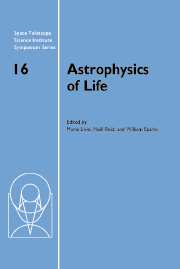 Astrophysics of Life
Astrophysics of Life Published online by Cambridge University Press: 29 August 2009
The search for Earth-like extrasolar planets is in part motivated by the potential detection of spectroscopic biomarkers. Spectroscopic biomarkers are spectral features that are either consistent with life, indicative of habitability, or provide clues to a planet's habitability. Most attention so far has been given to atmospheric biomarkers, gases such as O2, O3, H2O, CO, and CH4. Here we discuss surface biomarkers. Surface biomarkers that have large, distinct, abrupt changes in their spectra may be detectable in an extrasolar planet's spectrum at wavelengths that penetrate to the planetary surface. Earth has such a surface biomarker: the vegetation “red edge” spectroscopic feature. Recent interest in Earth's surface biomarker has motivated Earthshine observations of the spatially unresolved Earth and two recent studies may have detected the vegetation red edge feature in Earth's hemispherically integrated spectrum. A photometric time series in different colors should help in detecting unusual surface features in extrasolar Earth-like planet spectra.
Introduction
One hundred extrasolar giant planets are currently known to orbit nearby sun-like stars. These planets have been detected by the radial velocity method and so, with the exception of the one transiting planet, only the minimum mass and orbital parameters are known. Many plans are underway to learn more about extrasolar planets' physical properties from ground-based and space-based observations and via proposed or planned space missions. Direct detection of scattered or thermally emitted light from the planet itself is the only way to learn about a variety of the planet's physical characteristics.
To save this book to your Kindle, first ensure [email protected] is added to your Approved Personal Document E-mail List under your Personal Document Settings on the Manage Your Content and Devices page of your Amazon account. Then enter the ‘name’ part of your Kindle email address below. Find out more about saving to your Kindle.
Note you can select to save to either the @free.kindle.com or @kindle.com variations. ‘@free.kindle.com’ emails are free but can only be saved to your device when it is connected to wi-fi. ‘@kindle.com’ emails can be delivered even when you are not connected to wi-fi, but note that service fees apply.
Find out more about the Kindle Personal Document Service.
To save content items to your account, please confirm that you agree to abide by our usage policies. If this is the first time you use this feature, you will be asked to authorise Cambridge Core to connect with your account. Find out more about saving content to Dropbox.
To save content items to your account, please confirm that you agree to abide by our usage policies. If this is the first time you use this feature, you will be asked to authorise Cambridge Core to connect with your account. Find out more about saving content to Google Drive.